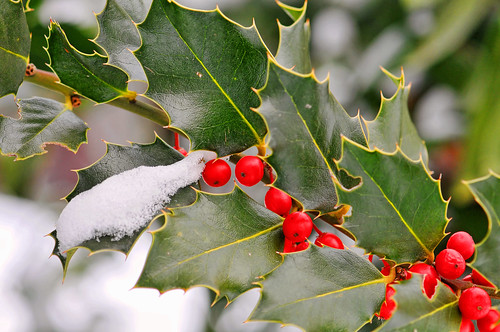Holly and snow by Tambako the Jaguar
This is the season when holly (ilex) is almost king. Who doesn’t love to see the shiny, dark leaves with the red (and black) and sometimes white, orange or yellow berried shrubs and trees? It is probably the most colorful plant in the late fall and winter season. That is the reason people love to decorate their homes with branches from these colorful plants.
But holly is especially wonderful growing in the garden. Perhaps when you list what you wish for this holiday season, you can ask for a holly to be planted in your garden in the spring- the best time to plant or transplant your holly.
By planting a holly, you will also be helping the birds in the winter. Waxwings gather in local hollies near me. Here is a video showing robins enjoying the fruit.
However, you may also be watching the deer browsing on your holly. Deer eat holly in spite of the spiny leaves. The most deer resistant ilex seems to be Ilex verticillata (Winterberry): This Deciduous holly has a 6 to 8 ft. spread, with bright red fruits that persist as long as not eaten by birds. Native to swampy places this holly also does well in light to medium moist loam. Both sexes needed for pollination. Sun or partial shade.
Some wildlife eat the berries, but be warned that they may cause mild stomach upset if ingested by humans.
In the next post on Friday titled “The Holly – Part II”, TheGardenLady will explain what conditions the holly likes best and how to choose from the 400 species of Ilex plants.

